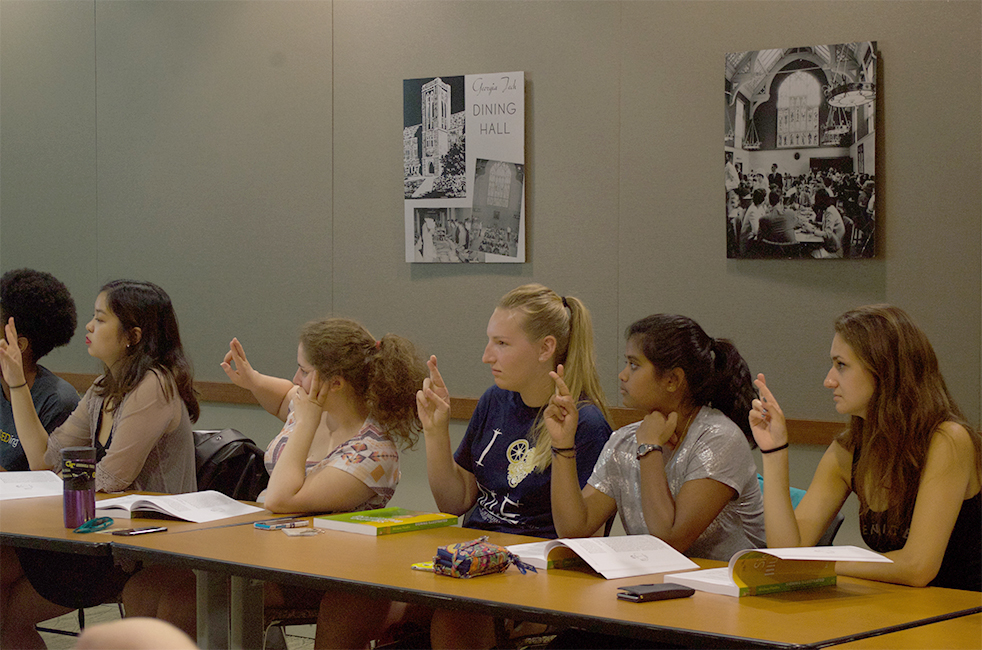For the 24 hearing students in the Student Center on Monday, the ten-week journey to learning American Sign Language does not start with a bang, but with hushed whispers. Before class, one student approaches the instructor to ask a question and is gestured towards a whiteboard. The instructor is deaf.
Andrea Kemp, from the Georgia Council for the Hearing Impaired, Inc., was born deaf because her mother had Rubella while she was pregnant. Kemp was born in Atlanta and went to the Atlanta Area School for the Deaf in Clarkson, GA. She graduated from Parkview High School in Gwinnett.
Kemp begins the class by showing a pre-made word document on the projection screen. When “speaking” to the class, however, she types on a blank word document.
“I can talk a little, but if you can’t understand me … [signs] stop!” Kemp uses the sign for “time-out” and waves her hand above her head as if trying to get someone’s attention.
The textbook, Signing Illustrated, is distributed, but Kemp stresses that there is “No homework :)”. She requests that students put away their cell phones, but she also lets the class know that there are no punishments. Students will get out of the class what they put into it.
Introductions are made. It is a standard “name, where you’re from, and why you’re taking the course.” The difference is that all of these specifics are answered by writing them down on a small easel whiteboard that fits about four or five names at a time.
Most students in the course are genuinely curious about American Sign Language. Some students simply expressed a love for learning languages. One student was in an ASL club in high school and wanted to continue learning.
Other students’ motivations are more pragmatic. Kayla from Illinois has deaf triplet uncles who she can only fingerspell with. Taylor from Tennessee has a deaf grandmother. Emily is unilaterally deaf with progressive hearing loss. Claire already knows a little because she has a little brother with speech issues. Dakota’s best friend is going deaf. These students hope the course can help them better connect with their friends and family.
Daniel Lovell, a third-year MATH major, is one student with prior language experience. “I know Latin (which is much less useful than ASL, apart from when you need to translate something) and I had a little bit of a running in Esperanto at one point which is even less useful than Latin,” Lovell said.
On the difficulty of learning ASL, Lovell stated that “[he thinks] it’ll be easier [than other languages]. The trick with learning [other languages] was learning to think in them really and once you did that, a lot of things came to me much quicker than they would have … if I didn’t understand something I could move my way through it at the flow of a language.” The advantage of ASL is knowing how to think in the language as all of the students are already fluent in English.
Though there are different reasons the group has come together, they all share a passion for ASL. The first class went over the basics of ASL, starting with the signing area, size of signs and the alphabet. With the book as guidance, Kemp explained how ASL is a simplified version of English. Instead of saying “I am going to the store,” one would sign “Me go store.” Kemp gave students a “sign name” as is common within the deaf community in order to avoid fingerspelling, or using the manual alphabet.
This isn’t the first time SCPC has offered an American Sign Language Class. In 2013, a different instructor taught the same ten week course on Tuesday evenings. Matt Pack, the SCPC Options Chair, said many students complained that they couldn’t attend a class on Tuesday evenings, and that Monday evenings were better suited to their schedules. The previous instructor recommended Kemp, and this year the class completely filled up.
Having a deaf instructor came as a surprise to the class. Lovell commented, “I actually think it’ll make the class better,” and noted that having a deaf instructor also offers more into the full immersion of the language another student remarks.
The course costs $50, which covers the cost of the textbook and instruction. This comes out to $5 for each one hour class. The textbook includes more than 1,550 signs along with an introduction covering the basics of ASL.
“I thought it was a really great price,” Lovell said. Another student commented that the novice environment and expert instructor are priceless, for many students had tried learning ASL previously to no avail.
Even after just one class, students were enthusiastic. The slower starting pace also helped one student who came in with no prior knowledge. The next weeks will cover more signs to help increase fluency. Students would readily recommend the course to their peers if it is offered again.
